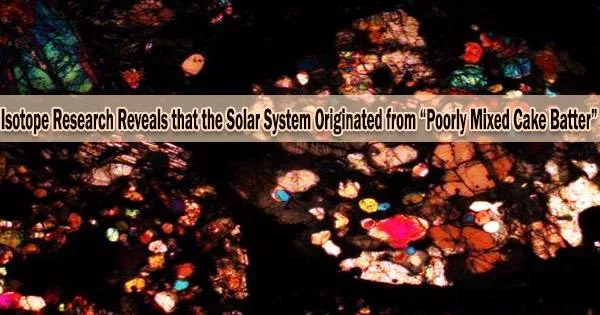Isotope research has shown that the solar system was formed from “poorly mixed cake batter.” This refers to the observation that the isotopic composition of different objects in the solar system (such as the Sun, the planets, and their moons) vary to a significant degree.
Earth’s potassium arrived by meteoritic delivery service finds new research led by Carnegie’s Nicole Nie and Da Wang. Their research, which was published in the journal Science, demonstrates that some primitive meteorites have a different combination of potassium isotopes than do other, more chemically treated meteorites. These findings may shed light on the mechanisms that built our solar system and influenced the makeup of its planets.
“The extreme conditions found in stellar interiors enable stars to manufacture elements using nuclear fusion,” explained Nie, a former Carnegie postdoc now at Caltech. “Each stellar generation seeds the raw material from which subsequent generations are born and we can trace the history of this material across time.”
It is possible for some of the material created inside stars to be ejected out into space, where it gathers as a cloud of gas and dust. One of these clouds fell in on itself more than 4.5 billion years ago to create our Sun.
The remnants of this process formed a rotating disk around the newborn star. These remnants, which included the parent bodies that subsequently disintegrated to form asteroids and meteorites, eventually merged to form the planets and other objects of the Solar System.
“By studying variations in the isotopic record preserved within meteorites, we can trace the source materials from which they formed and build a geochemical timeline of our Solar System’s evolution,” added Wang, who is now at Chengdu University of Technology.
Each element has a specific amount of protons, but the neutron counts of its isotopes vary. The composition of the material cloud from which the Sun was formed is reflected in the distribution of various isotopes of the same element throughout the Solar System.
The extreme conditions found in stellar interiors enable stars to manufacture elements using nuclear fusion. Each stellar generation seeds the raw material from which subsequent generations are born and we can trace the history of this material across time.
Carnegie’s Nicole Nie
The isotopic composition of meteorites can be used to establish how many stars contributed to this so-called solar molecular cloud, but how evenly they distributed their contributions is unknown.
Wang and Nie along with Carnegie colleagues Anat Shahar, Zachary Torrano, Richard Carlson, and Conel Alexander measured the ratios of three potassium isotopes in samples from 32 different meteorites.
The fact that potassium is a so-called moderately volatile element one with a low boiling point and a high degree of evaporation makes it particularly intriguing.
As a result, it is difficult to search for patterns in the isotopic ratios of volatiles that predate the Sun since they don’t last in the intense conditions of star formation for long enough to leave a legible record.
“However, using very sensitive and suitable instruments, we found patterns in the distribution of our potassium isotopes that were inherited from pre-solar materials and differed between types of meteorites,” Nie said.
They discovered that more potassium isotopes produced by massive star explosions known as supernovae were present in some of the oldest meteorites known as carbonaceous chondrites, which formed in the outer Solar System.
The majority of meteorites that strike Earth are non-carbonaceous chondrites, which have the same potassium isotope ratios as Earth and other planets in the inner Solar System.
“This tells us that, like a poorly mixed cake batter, there wasn’t an even distribution of materials between the outer reaches of the Solar System where the carbonaceous chondrites formed, and the inner Solar System, where we live,” concluded Shahar.
The origins of the volatile elements on Earth have been a long-standing research goal for Carnegie Earth and planetary scientists. On the backs of carbonaceous chondrites, some of these elements may have traveled all the way from the outer Solar System to this location.
But since the distribution of pre-solar potassium isotopes in non-carbonaceous chondrites matched that of Earth, these meteorites are most likely the planet’s potassium’s primary source.
“It is only recently that scientists challenged a once long-held belief that the conditions in the solar nebula that birthed our Sun were hot enough to burn off all volatile elements,” Shahar added. “This research provides fresh evidence that volatiles could survive the Sun’s formation.”
More investigation is required to incorporate this new knowledge into our models of planet formation and determine whether it modifies any ingrained notions about how Earth and its neighbors originated.
This work was supported by a NASA NESSF fellowship, Carnegie postdoctoral fellowships, and a Carnegie Postdoc × Postdoc (P2) seed grant.





